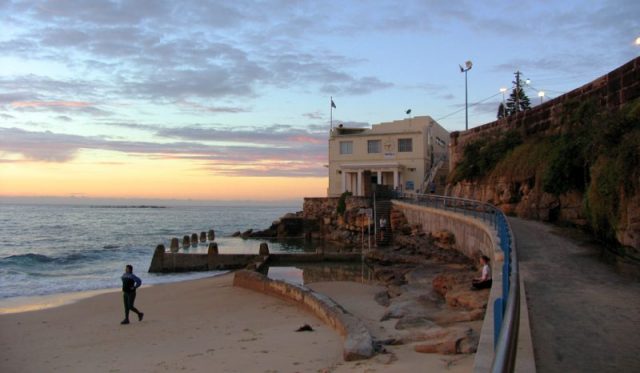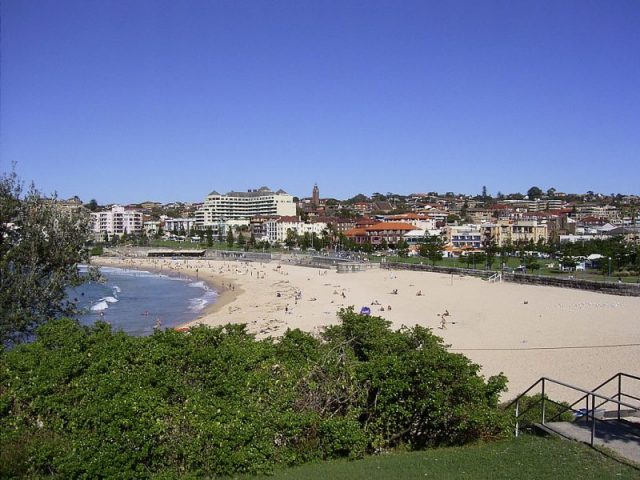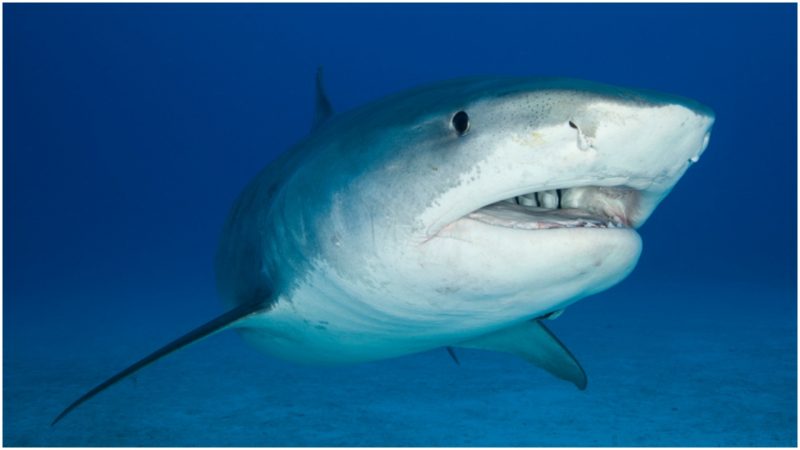“Visitors to the Coogee Aquarium were horrified this afternoon when a 14 ft shark on exhibition threshed the water to foam and disgorged a human arm. The limb was that of a man and bore a tattooed picture of a boxer. There was a piece of rope tied around the wrist. The arm was comparatively well preserved.
“The shark was caught on Thursday and immediately placed in the pool. Since it has been in captivity it has refused to eat. Detectives have attempted to take fingerprints in the hope of establishing identification of the victim.” – The Argus, Friday, April 26, 1935.
Thankfully, the victim of the shark revealed to the world in the spring of 1935 was identified pretty quickly, all things considered.
Only two people in and around Sidney, Australia, were found to have such a distinctive tattoo. One of them had both his arms still attached to his body, while the second, who according to his wife and his brother was last seen a couple of weeks before this incident, had the exact boxer tattooed on his left arm. His name was James “Jimmy” Smith, he was a former boxer, the hand was his, and his family never saw the rest of him again. Unfortunately, aside from the confirmed identity, everything else more or less remained unanswered and the case in time grew to be The Shark Arm Case, one of the greatest murder mysteries in Australia.
According to their own reports, about a week earlier fishermen Bert Hobson and his son Charles had caught the large fish by accident while they were fishing at Coogee Beach in New South Wales, a couple of miles southeast of Sidney. They were trying to catch a much smaller shark. Interestingly enough though, hooked and stuck as it was, their captured fish served as bait itself and brought the significantly larger one closer to shore and on to the hook in a manner of speaking. She was alive and helplessly tangled up so they called a towing service and carefully brought her to the Coogee Aquarium.
Shark attacks were on the rise at the time. That early March alone, three kids ended up as victims to Australia’s “public enemy number one” in Sidney and New South Wales. So a huge tiger shark was to be a nice specimen to study and a great attraction for those who wished to stare at the beast up close. Little did they know that the shark had bit more than it could swallow, or swallowed more than it could digest in this case in particular, and would spit a full man’s arm in the pool right in front of their eyes.
At first, it was believed to be a sick prank, but when police arrived it was confirmed that the arm was genuine, and furthermore it wasn’t chewed off, pointing to something more sinister than just another shark attack. Coroners later confirmed the arm was cut off ineptly with a blade. They began their investigation from what they had and didn’t have. An arm, and the missing person who was lacking one.

Jimmy was an ex-boxer who after failing at boxing for a living turned to “whatever job I could score for a living” and was not a complete stranger to the police. He had some troubles with the law but nothing major really. Aside from the occasional punches thrown and teeth knocked, he worked (though, for some very shady characters) as a contractor and was last seen alive approximately 10 days before his hand was disgorged out of the belly of the beast. The police investigation in time concluded that the last man he was seen with was a friend of his, a certain Patrick Brady. Smith was a guest at the Cecil Hotel at Cronulla right before he went missing and he and this man, according to the hotel manager and eyewitnesses, were drinking and left the hotel’s pub together late in the night.
Brady, his friend, rented a small cottage nearby on the prestigious Taloombi Street on the shore of Guanamatta Bay, and he left it the day after they were last seen together by the hotel’s employees. Interestingly enough, the landlord said that when he came to inspect the empty cottage early in the morning, he found a brand new mattress on his bed, wet walls, and a scrubbed rowboat that was also rented along with the cottage. Something happened, and someone cleaned up the place thoroughly. All evidence was pointing toward Brady and this small cottage, which according to police was the most likely place where Smith had been murdered.
Furthermore, as they were asking around in Cronulla, a cab driver said to them that late in the night he drove a man from there to Lavender Bay on the North Shore. The man appeared to be very nervous according to the driver and eager to get there as quickly as possible. The police showed him a picture of their suspect. It was Brady, and he had been dropped off right in front of Reginald Lloyd Holmes’ home.
Holmes was a well-respected member of the community, an upstanding boat builder who found success in a time when the country was hit brutally by the Great Depression. He was a family man, a father of two, and a strong supporter and financier to the local Presbyterian Church above everything else.
But, the police were not surprised as might be expected. Their first lead just happened to be none other but him.
While to everyone else he was a handsome gentleman, a loving father, and a devoted Christian, to the Sidney police, Holmes was one of those shady characters Smith used to work with and he was for a long time suspected of fraudulent practices and, police believed, directly involved in a major drug-smuggling ring. After Smith’s family called to say that the hand shown in the papers was Jimmy’s, police found him in their database. His fingerprint matched exactly with that of the hand and he had worked for Holmes.
Not long ago Holmes was building some apartments at McMahons Point that, after they were insured for a hefty amount of money, strangely went up in flames all of a sudden. A few of his boats were also insured heavily, and they went up into flames or down to the bottom of the ocean. They believed that Holmes was using his boats to pick up cocaine and heroin for the mafia that was booming at the time and insured his profit by destroying all the evidence of his involvement. It was a win-win for everyone, including Smith, who as they found was employed to “oversee” the construction of the homes and worked as a driver for his boats.
But then the Pathfinder case happened. One of his luxurious boats was sunk under suspicious circumstances and opened the door for further investigation. This led police to believe that Holmes had the motive to kill Smith, or he was pressured to “deal” with the problem at hand by someone else. However, nothing was connecting him directly to the actual murder and in the interest of the investigation and in search for more evidence, the police went to the closest lead instead, before confronting Holmes. A man previously suspected of forgery during and after World War I was the third name found in all of these fraudulent practices, and according to Smith’s family was also a dear friend of Jimmy. Patrick Brady, who else. That’s why the cab driver story didn’t surprise them, it only confirmed what they had already suspected. They knew it wasn’t just Brady.
Both were brought in for questioning in the Central Police Station but refused to cooperate and confess their involvement, though Brady allegedly confirmed he was with Jimmy that night and had rented the cottage but was nowhere near it, for he was on his way towards Holmes on an entirely different matter and left his friend behind. Holmes denied he knew Brady altogether. They realized Holmes was involved, but at this point, they had to let him go. However, Brady was kept for suspected forgery in the meantime to pressure Holmes to make a mistake out of fear that his accomplice would squeal and tell the truth.

And he did, either in a state of panic or having a nervous breakdown. On May 20, 1935, Holmes tried to take his own life on one of his speedboats in Lavender Bay, but the small caliber bullet only scratched him. The incident was reported by eyewitnesses, and when he saw the water police approaching he turned his engine on and triggered a four-hour chase through the morning traffic in and around Sidney Harbor until he finally gave up in open sea when his engine failed. He was ready to cooperate and speak the truth.
But Holmes never did, unfortunately. At least not inside the court of law. On the morning of June 12, 1935, the day when the trial was about to start, he was found dead in his car at Dawes Point under the Harbor Bridge with three fatal wounds in his chest.
The trial went on without him and 39 witnesses were called to testify against Brady and speak about his whereabouts. But without Holmes’ testimony, there was no clear motive linking Brady to the murder, and most importantly, according to his lawyer, there was no body of Smith, and without a body, there wasn’t any murder. For all we know, the lawyer said, he could be alive somewhere minus an arm.
Without hard evidence, Brady walked free. The body of James Smith was never found, and no one was ever convicted of a crime that never that took place according to the law as it seems.
Some claim Brady brought Jimmy’s hand that night to blackmail Holmes after previously tossing the rest of the body in the ocean packed in a trunk, and Holmes threw the arm in the water in a state of panic afterward. Others say that Holmes ordered the killing because Jimmy was blackmailing him and the hand was just the evidence that it was a done deal. However, a few go as far as to suggest that Smith was actually an informant to the police and got a proper “Sydney Send-off” by the mafia, and Holmes was then killed so they could cut all their ties with him and this case.
